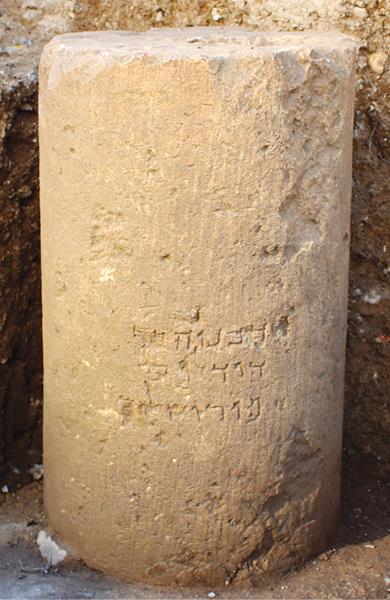
On October 9, 2018, archaeologists at the Israel Museum held a dramatic unveiling of a stone column section that was unearthed during an excavation directed by the Israel Antiquities Authority’s Danit Levy near Binyanei Ha’Uma in Jerusalem.
On the face of the column drum, which had been discovered in reuse as part of a Roman structure, was a 2000-year-old inscription written in Hebrew letters of a style used during the reign of Herod the Great (r. 37–4 B.C.E.). Apparently, someone from the first century B.C.E. jotted his name and city on a column in Jerusalem. According to scholars, the inscription reads, “Ḥananiah son of Dodalos of Jerusalem.”
Exactly who this individual was remains a mystery. Perhaps it identifies the one who carved the column, or perhaps it’s a graffito carved by a passerby. Whoever it was, he left his mark.

At first glance, the inscription appears rather benign. But to those of us who study Jerusalem, its history, and especially the text of the Hebrew Bible and who pay particularly close attention to the spelling of key words, this inscription carries far more linguistic weight than that of the stone itself.
The Jerusalem Column is the first inscription from the Second Temple period where the full spelling of the Hebrew name of Jerusalem (ירושלים) appears. By “full spelling,” I mean a spelling of Jerusalem that includes the letter yod (י) between the lamed (“l”; ל) and final mem (“m”; ם) at the end of the name.
As many readers may know, Jerusalem in Hebrew is pronounced as Ye-roo-sha-lai-eem. However, early in the history of the Hebrew language, words weren’t always written with the vowels we see today, nor with many of the vowel letters—typically waw (ו) and yod (י), but also aleph (ℵ) and heh (ה)—that appear more frequently in spellings later in Hebrew’s development. (William Schniedewind discusses this phenomenon later in this issue.)
Early in the Hebrew language’s development, Jerusalem was spelled without the final yod, as ירושלם. In fact, of the 660 times that the name “Jerusalem” appears in the Hebrew Bible, all but five instances appear as this shorter version, ירושלם. However, in Jeremiah 26:18, Esther 2:6, 1 Chronicles 3:5, and 2 Chronicles 25:1 and 2 Chronicles 32:9—all relatively late Hebrew Bible texts chronologically—the spelling of Jerusalem appears as ירושלים, that is, with the extra yod as the penultimate letter.
What is interesting is that the Masoretes, the medieval Jewish scribes who added the vowels and cantillation marks to the Hebrew Bible to standardize pronunciation and make it easier to read, pointed the shortened spellings of Jerusalem (the instances without the extra yod) so that they would be pronounced as if the yod were present. That is to say, the Masoretes were convinced that Jerusalem was always pronounced in antiquity the way it was pronounced in their time—and the way it is pronounced today in Israel—as Yerushalayim, not as Yerushalem. The only problem was that there was no archaeological evidence to prove this pronunciation … until now!
With the discovery of the Jerusalem Column, we have our earliest archaeological evidence that Jerusalem was spelled, and therefore indeed pronounced, with the second yod, not as Yerushalem, but as Yerushalayim during the Second Temple period, just as it was spelled in the five instances of Jerusalem that appear in the late texts from the Hebrew Bible. The column is archaeological corroboration not only of these later Biblical spellings, but also of the Masoretic assumptions from a millennium later. It is also further confirmation of prevailing scholarly theories concerning the history of the Hebrew language, spelling, and the orthographic inertia that pervades scribal convention.
And all this from just one tiny letter—a little yod—a letter that the King James Version of Matthew 5:18 transliterates as the common word we still use today for something written quickly: “jot.”—B.C.

